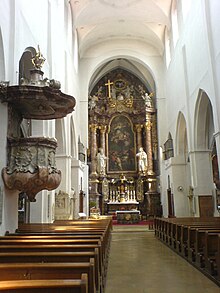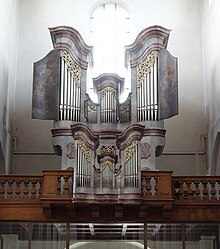Franciscan Church (Ingolstadt)
The Franciscan Church of the Assumption of Mary in Ingolstadt is an early Gothic three- aisled basilica with flat roofs . Today it is again the monastery church of the Franciscan monastery in Ingolstadt , which has been a Capuchin monastery since 2006 . It has a length of 71.70 meters, is 20.65 meters wide and 28.60 meters high. Like many other Franciscan churches, it does not have a steeple , but only has a small roof turret .
history
In 1270 the Upper Bavarian Duke granted Louis II, Duke of Bavaria to build a monastery of the Friars Minor outside the first city wall of Ingolstadt. Construction of a monastery church began as early as 1275, and the choir altar was consecrated in 1277. The chronicles show the visit of Emperor Ludwig the Bavarian to the church on January 13, 1314 . The exact form of the building for the early 14th century can only be assumed, although a dendrochronological examination of the roof structure allows it to be dated to the period between 1302 and 1304. What is certain is that the reconstruction of the church in its current form was only likely to have begun towards the end of the 14th century around 1383 and extended over several decades.
The choir , which is the full width of the central nave , was also rebuilt in the 14th century . Other structural changes affected the curvature of the ships. The side aisles were vaulted around 1500 and the central nave between 1716 and 1718. In the 18th century, after a fire, the interior was partially redesigned with the late baroque high altar , with numerous Gothic decorations being removed. As early as 1621, the Observants, today's Franciscans, moved into the monastery and church. Since the University of Ingolstadt was founded in 1472, the monastery church has served as a burial place for both professors and the city's high-ranking military. In 1802 the Franciscan monastery was secularized .
With the reintroduction of the Franciscans in Bavaria in 1827 by King Ludwig I , the Franciscans received a new home in the monastery, also secularized in 1802, ob der Schutter der Augustinian . The church was converted into a garrison church in 1837 . After the destruction of the monastery ob der Schutter and the associated church in an air raid on Ingolstadt during the Second World War, the Franciscans got their old church back. The Franciscans left the monastery in 2005 and the Capuchin Order has used it since 2006.
On June 1, 1964, the Church was given by Pope Paul VI. the title Basilica minor .
Furnishing
Inside the Franciscan Church, the more than 100 tombstones and epitaphs are particularly striking . Among them is the grave of the astronomer Peter Apian , for example . In the southwest corner of the church is the cross altar with a popular depiction of the crucified. In the Messbund chapel, the western of the two side chapels, is the Schutter Madonna, the old pilgrimage image of the Ingolstadt Messbund .
organ
The organ was built in 1981 by Orgelbau Mathis . The slider chests -instrument has 35 registers on three manuals and pedal . The playing and stop actions are mechanical.
|
|
|
|
||||||||||||||||||||||||||||||||||||||||||||||||||||||||||||||||||||||||||||||||||||||||||||||||||||||||||||||||||||||||||||||||||||||||
- Coupling: I / II, III / II, I / P, II / P
Monuments
On the outside of the church there are several monuments and memorial stones on both Franziskanerplatz and Schrannenstrasse, including those for the war missing in the city of Ingolstadt.
One of them (outside north aisle) is the epitaph of the Freising Canon Christoph Langenmantel vom Sparren († 1538), who secretly brought Martin Luther out of the city of Augsburg on the night of October 19-20, 1518 and helped him to escape. According to a legend, he is said to have taken him to Hohenschwangau Castle afterwards . King Max II had this legend depicted in the Schwangau room by the painter Wilhelm Lindenschmit in the form of a romanticizing mural on which the canon buried here is immortalized in knight clothing.
Epitaphs
- Epitaph for Hans and Dorothea Esterreicher
- Johann von der Leiter ( epitaph in the Franciscan Church)
- Christoph Gewold
literature
- Vinzenz Mazet and Hugo Schnell: The Franciscan Church Ingolstadt. Art Guide No. 598 , Munich 1954.
- Gerd Hit u. a .: Historisches Ingolstadt , Bamberg 1988, p. 32ff.
Web links
- Ingolstadt city museum about the time of the church as a garrison church
- Tourism website of the city of Ingolstadt about the church
Individual evidence
- ↑ To the organ
- ^ Doris Wittmann: Epitaphe in der Franziskanerkirche , Part 2, in: Ingolstädter Heimatblätter , Volume 3, No. 16, 2012; (PDF view)
- ^ Gottlob Egelhaaf: German history in the sixteenth century up to the Augsburg Religious Peace , Volume 1, p. 168, BoD - Books on Demand, 2015, ISBN 3734007615 (reprint); (Digital scan)
- ↑ Joseph von Hormayr : The golden chronicle of Hohenschwangau , Munich, 1842, p. 178, (digital scan)
- ↑ Website on Luther's escape in the Northern Bavaria portal
- ↑ Neue Flora . (Koversationsblatt), No. 13, Augsburg, January 22, 1835 page 49 of the vintage; (Digital scan)
Coordinates: 48 ° 45 ′ 56 " N , 11 ° 25 ′ 28" E





